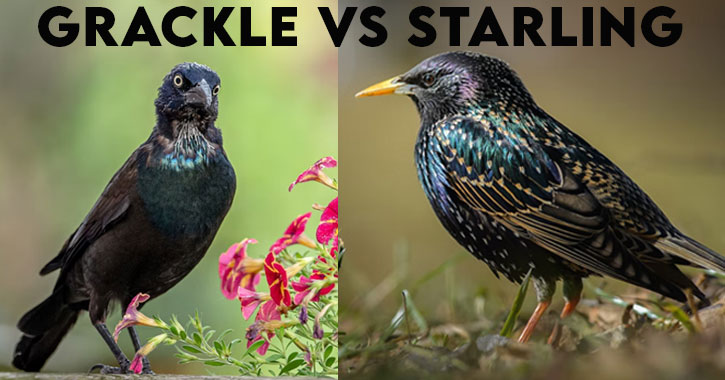If you’ve ever gotten confused between grackle vs starling birds, you’d be surprised that many people do too! It’s such a common mistake.
Just look at these gorgeous dark-tinged birds and how their emerald, blue-hued, and speckled white feathers strike you at first glance.
Of course, the differences between these two widespread US birds are apparent to the trained eye.
But if you’re a new birder or want to confirm what type of bird you just saw, this post should give you some clarity.
Starlings and Grackles Basic Info
Before we compare the two, let’s talk about the facts first:
Starlings and grackles are birds of different species and families. Starlings belong to the family Sturnidae, while grackles are part of the family Icteridae.
STARLING (Sturnus vulgaris)
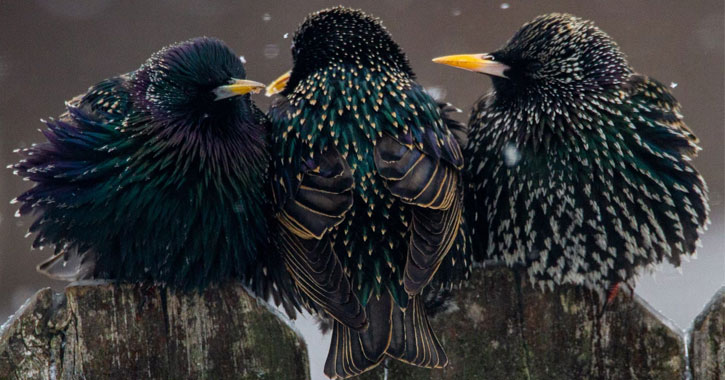
The common starling was once known as European starling because they were natives of Europe, Asia, and Africa.
They didn’t migrate here to the US on their own. Instead, their roots came from the first 100 starlings released in New York in the 1890s as a homage to William Shakespeare.
- Population: Starlings are now found all over the world and across the United States. Their population in North America is approximately 200 million, which is why they are considered a nuisance or pests in some areas.

- Habitats: The common starling prefers open grasslands such as reedbeds, golf courses, farmlands, fields, grazing pastures, and even urban/suburban areas. They also live around forests, woodlands, coastal areas, and areas with low trees or shrubs where they could take cover.
- Fun facts: Starlings are one of the few birds that lay blue eggs. Emus, House Finches, and American Robins are species with striking blue eggs.
GRACKLE (Quiscalus quiscula)
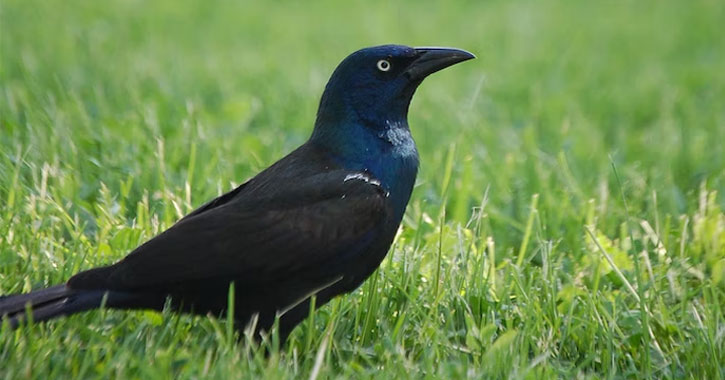
Grackles are part of the crow family. It’s why they’re often mistaken for the all-black crows, but upon closer look, the deep blue heads make it clearer that they’re a different kind of bird.
In North America, the Common Grackle is considered an agricultural pest species due to the million-dollar worth of damage to rice, sunflower, corn, and other crops each year.
- Population: Common Grackles are abundant and widespread, but their populations have declined by nearly 2% per year from 1966 to 2019. Today, there are about 69 million of these bird species.
- Habitats: Common Grackles often flock near open woodland, marshes, agricultural fields, suburbs, parks, and other open and wet areas.
- Fun facts: Grackles have a magnetic mineral in their necks, beaks, and heads. This mineral (called magnetite) allows them to use the earth’s geomagnetic fields to navigate.
Grackle vs Starling: What are the Differences between a Starling and a Grackle?
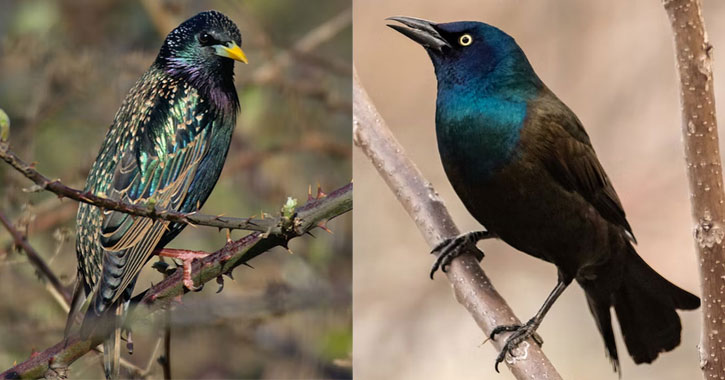
Grackles and starlings are both dark-colored birds that travel in large noisy groups.
European starling vs grackle appearance
When it comes to the appearance of these birds, the noticeable differences are seen in their:
MAIN COLORS:
- Starlings have glossy black plumage, but younger starlings are graying-brown. Females look less glossy than males. The most distinct thing about starlings is that the spots on their backs resemble a “starry night.”
- Male grackles have glossy black plumage, but females have a mix of dark brown and paler brown.
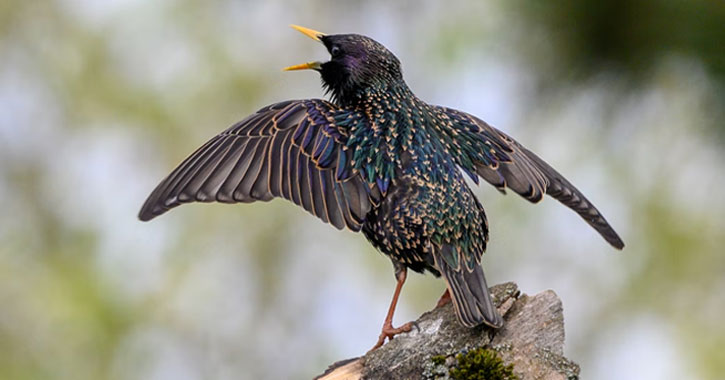
HEADS
- The heads of starlings are mostly brown and black
- Grackles have a black “mask” on their face
BEAKS
- Male starlings have blue bills (but yellow-colored in the summer), while females have pink bills.
- Grackles have yellow beaks
EYES
- Starlings have dark eyes (dark brown for males, grayish for females)
- Grackles have yellow eyes
WINGS
- Starling wings are fairly long and pointed.
- When in flight, the wings of the common grackles appear short compared to their tails.
LEGS
- Starlings have pink legs
- Grackles have dark legs
TAILS
- Starling tails are often shorter than their bodies without visible patterns/markings.
- Grackle tails are longer with a distinct orange when in flight.
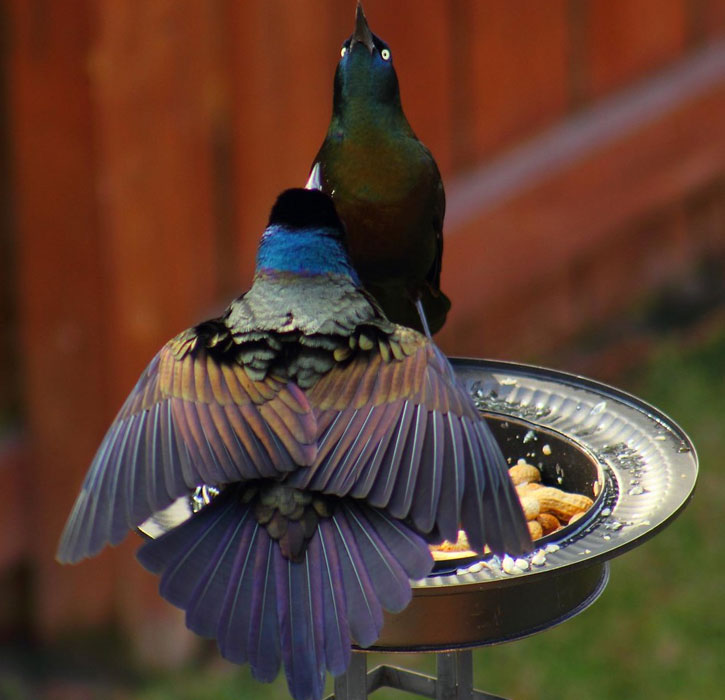
See the grackle with its wings spread?
The metallic purple and greens look very similar for males of both species, especially during winter when the plumage of both starlings and grackle become less vibrant but more spotted.
Starling vs Grackle Size: Who’s Bigger?
Starling ranges from 8 to 9 inches in length with a wingspan of 12 to 16 inches. They weigh around 2 to 4 ounces with an oval-shaped body that tapers at the head and tail.
Grackles range from 11 to 13 inches in length with a wingspan of 14 to 18 inches. They weigh around 2 to 5 ounces with long and slender bodies.
Starling vs Grackle Sound
Common grackles have one of the most distinctive sounds in the birding world thanks to their harsh, loud machine-gun-sounding calls that they use to communicate with their flock members. They also make quick rapid calls when alarmed or taking flight.
Starlings are the opposite. They have melodious and pleasant calls, which is why their sounds are often used in movies for general “bird sounds.”
Starling vs Grackle Behavior
Starlings are gregarious, breeding in close proximity to other pairs.
They can be aggressive scavengers and pests to the agricultural industry since they can easily destroy crops and gardens with one swoop.
After all, a flock of starlings can go as many as 20,000 birds in the winter.
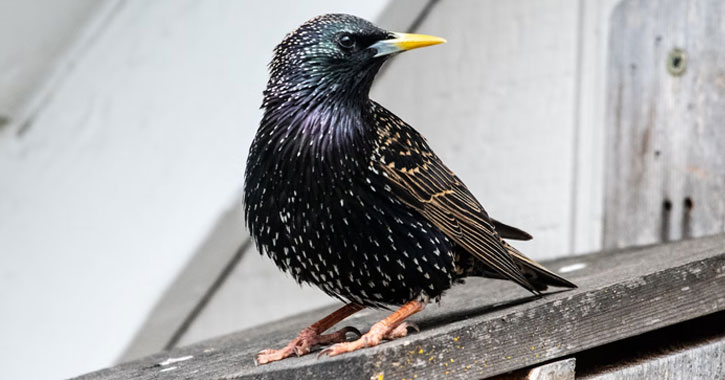
Just like crows and ravens, grackles are able to recognize and remember different colors and faces. They’ve also been known to imitate the sound of other bird species.
Grackles prefer to walk on the ground, instead of jumping or hopping around like regular birds.
The murmuration of grackles is a sight to behold! They form a v-shape in the sky with a leader bird at the front and the rest flying closely behind.
If you see them flying above, observe for a couple of minutes and you might be surprised.
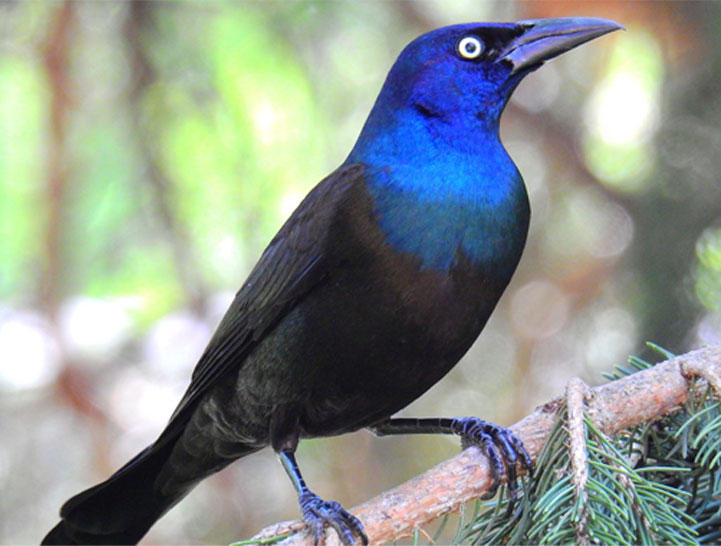
What do starlings and grackles eat?
Starlings feed only on insects, seeds, nuts, grains, legumes, fruits, and vegetables, foraging in trees or on the ground.
Grackles eat everything but love corn crops the most. They eat nuts, fruits, bread, crackers, and insects like crickets, millipedes, and caterpillars.
Do Grackles and Starlings live in the same places?
Grackles are friendly birds. They migrate and roost in large flocks with other grackles and even other birds.
Starlings also have the same behavior, which is why they’ve been seen flying together with grackles in one large group.
Grackles and starlings have similar habitats and favorite foods. These birds are known to collaborate and communicate, especially when dealing with predators.
There is an exception though – these birds do not flock together during nesting season.
Pictures of Grackle vs Starling
Of course, the best way to see the differences between grackles and starlings is to see pictures of these bird species, so here they are:
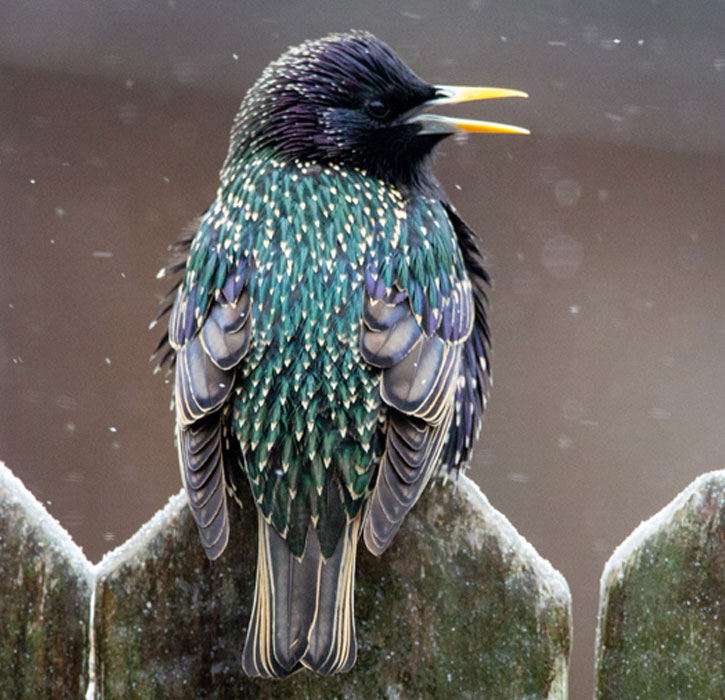
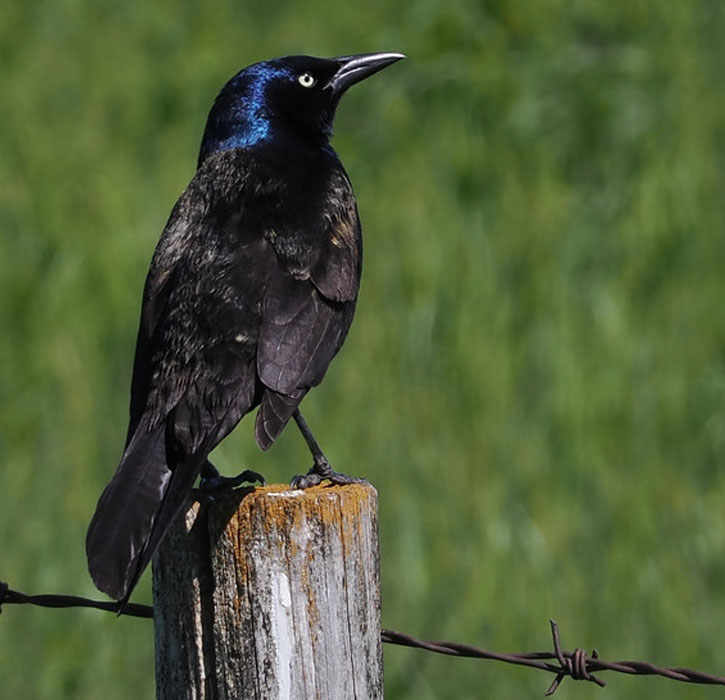
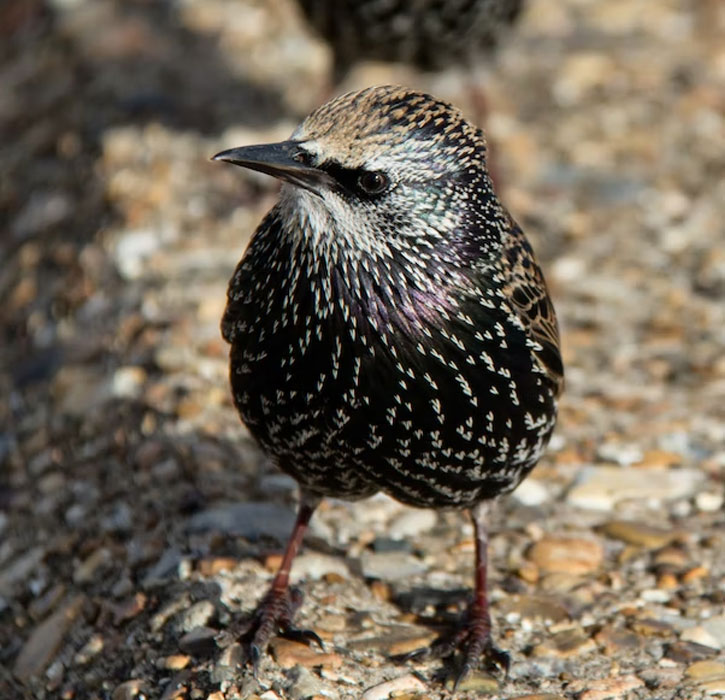
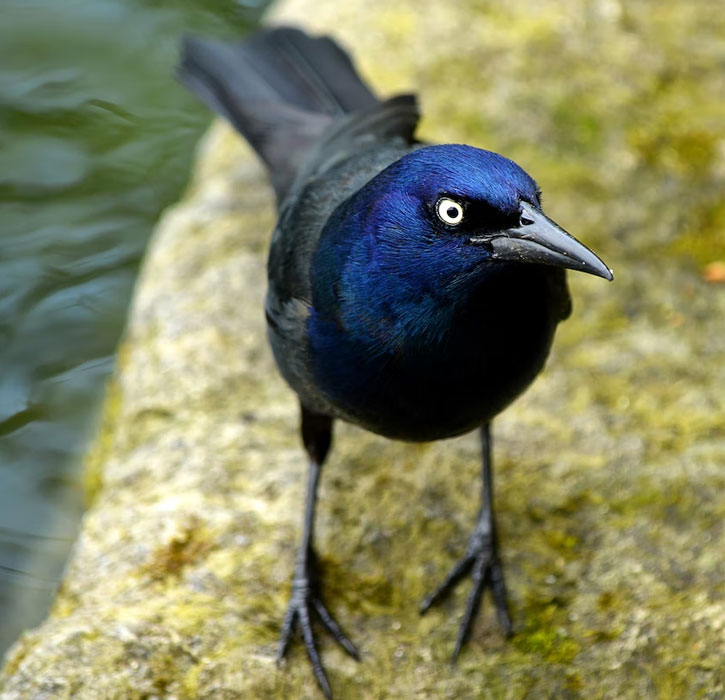
Now that you have an idea between the similarities and differences between these awesome black birds, it could now be a bit easier to identify which ones are starlings and which ones are grackles if they visit your backyard, or if you see them outside.
If you want to see other beautiful birds, go check out these 10 of the world’s prettiest purple birds.
